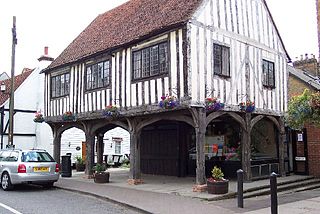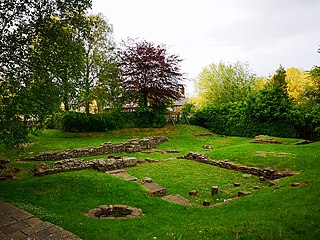
Baron Petre, of Writtle, in the County of Essex, is a title in the Peerage of England. It was created in 1603 for Sir John Petre. His family has since been associated with the county of Essex. He represented Essex in parliament and served as Lord Lieutenant of Essex. Lord Petre was the son of Sir William Petre, Secretary of State to Henry VIII, Mary I, Edward VI and Elizabeth I. Sir William acquired Ingatestone Hall and the surrounding manor from Henry for the full market value after it had been surrendered to the King by Barking Abbey during the Suppression of the Monasteries.

Ilton is a village and civil parish in Somerset, England, situated 8 miles (12.9 km) south-east of Taunton, and 2 miles (3.2 km) north of Ilminster in the South Somerset district. The village has a population of 854. The parish includes the hamlets of Ilford and Cad Green with its 16th-century almshouses.

Eccleston is a village and civil parish of the Borough of Chorley in Lancashire, England. It is beside the River Yarrow, and was formerly an agricultural and later a weaving settlement.

Abbots Ripton is a village and civil parish in Cambridgeshire, England. Abbots Ripton is situated within Huntingdonshire which is a non-metropolitan district of Cambridgeshire as well as being an historic county of England. Abbots Ripton lies approximately 4 miles (6 km) north of Huntingdon on the B1090.

Sturmer is a village in the county of Essex, England, 2 miles (3 km) SE of Haverhill and close to the county border with Suffolk. Its name was originally "Stour Mere", from the River Stour and is explicitly mentioned in the Domesday Book of 1086. A Tudor illustration of the mere from the summer of 1571 exists in the National Archives. The mere still exists today to the east of the village. The village also gives its name to the Sturmer Pippin apple which was raised by Ezekiel Dillistone from 1831, and grown in the orchards of the village.

East Horndon is a village and former civil parish, now in the parish of West Horndon, in the south of the borough of Brentwood in Essex in the East of England. It is situated just south of the A127 road near Herongate. The village Church of All Saints is located to the north of the A127, and is redundant, but in the care of the Churches Conservation Trust. In 1931 the parish had a population of 440.

West Horndon is a village and civil parish in the south of the Borough of Brentwood, Essex on the boundary with Thurrock. It is located 5 miles east of Upminster in the London Borough of Havering, East London and 20 miles (32 km) east north-east of Charing Cross in Central London. The civil parish also includes East Horndon and Dunton Hills.

Ingrave is a village and former civil parish in the Brentwood in Essex, England. It is situated on and around the A128 road, 2 miles (3.2 km) southeast of the town of Brentwood. Together with the adjoining village of Herongate, it now forms the Herongate and Ingrave civil parish. In 1931 the parish had a population of 692. On 1 January 1937 the parish was abolished and merged with Brentwood.

Weeting Castle is a ruined, medieval manor house near the village of Weeting in Norfolk, England. It was built around 1180 by Hugh de Plais, and comprised a three-storey tower, a substantial hall, and a service block, with a separate kitchen positioned near the house. A moat was later dug around the site in the 13th century. The house was not fortified, although it drew on architectural features typically found in castles of the period, and instead formed a very large, high-status domestic dwelling. It was probably intended to resemble the hall at Castle Acre Castle, owned by Hugh's feudal lord, Hamelin de Warenne.

Ingatestone Hall is a Grade I listed 16th-century manor house in Essex, England. It is located outside the village of Ingatestone, approximately 5 miles (8.0 km) south west of Chelmsford and 25 miles (40 km) north east of London. The house was built by Sir William Petre, and his descendants live in the house to this day. Part of the house is leased out as offices while the current Lord Petre's son and heir apparent lives in a private wing with his family. The Hall formerly housed Tudor monarchs such as Queen Elizabeth I.

Horndon on the Hill is a village, former civil parish and Church of England parish in the unitary authority of Thurrock, in the county of Essex, England. It is located close to the A13, around one mile northwest of Stanford-le-Hope and around two miles northeast of Orsett. The village area falls within the Orsett ward of Thurrock District Council. In 2019 it had an estimated population of 1517. In 1931 the parish had a population of 1052.

Thorndon Hall is a Georgian Palladian country house within Thorndon Park, Ingrave, Essex, England, approximately two miles south of Brentwood and 25 miles (40 km) from central London.

Ingarsby is one of the best preserved deserted medieval villages in England. It is situated about six miles (10 km) to the east of Leicester, and a little to the north of Houghton on the Hill. The majority of the site, which is situated on a west facing slope and lies on both sides of the Houghton to Hungarton road, is now a scheduled monument.

All Saints' Church is a redundant Anglican church in the village of East Horndon, Essex, England. It is recorded in the National Heritage List for England as a designated Grade II* listed building, and is under the care of the Churches Conservation Trust. The church stands north of the village, and northwest of the junction between the A127 and A128 roads, some 4 miles (6 km) south of Brentwood.

Shotwick Hall is a former manor house in the village of Shotwick, Cheshire, England. It replaced an earlier manor house that stood on a moated site some 150 metres to the west. The hall and four associated structures are listed buildings, and the moated site is a Scheduled Monument.

Thorndon Park Chapel (The Petre Chapel) is a former Roman Catholic private chapel situated in Thorndon Park, near the grounds of Thorndon Hall near Ingrave, Essex, England. It is recorded in the National Heritage List for England as a designated Grade II* listed building, and is under the care of the Historic Chapels Trust.

Housham Tye is a hamlet in the civil parish of Matching, and the Epping Forest district of Essex, England.

This is a list of scheduled monuments in the English county of Lancashire.


















